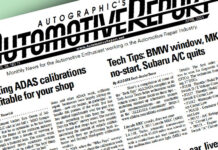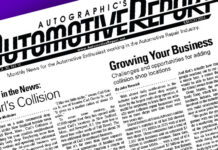Scanning, ADAS calibrations offer new challenges, opportunities for collision repairers
By John Yoswick
As vehicle safety systems like automated braking, lane-departure warning and forward-collision avoidance begin to cut into the number of crashed vehicles coming into autobody shops, the technology also brings some new opportunities for collision repairers as well. That’s because the increased need for vehicle scanning and advanced driver assistant system (ADAS) calibrations are adding to the typical repair order.
Jake Rodenroth of asTech, which provide remote scanning services for shops, points to a simple headlamp replacement for the Toyota Avalon as an example of the growing complexity of vehicle repairs. The automaker’s procedure for replacing a headlamp on a 2006 Toyota Avalon is just two pages. (Rodenroth said it’s important to note, however, that Toyota updated that procedure just this past April, a reminder that OEM procedures may evolve over time.) The headlamp replacement for the 2019 Avalon, however, is a 5-page procedure, Rodenroth said, including the necessary calibrations.
“The bill-payer and the customer need to understand, for example, that there’s going to be miles put on the vehicle because of the drive test,” he said. “All that needs to be discussed up front.”
He said the OEM procedure for just disconnecting and reconnecting the battery on a 2013 Chevrolet Cruze is seven pages long, and calls for “volatile memory programming,” which initializes the mirrors and sunroof. If a shop doesn’t read that procedure, Rodenroth said, they won’t see the note that indicates the vehicle’s start/stop feature also won’t function “until the vehicle is allowed to sit for at least three hours undisturbed.” If the customer isn’t told that, he said, they’re likely to come right back after they leave the shop to say that system isn’t working at stop lights.
Some vehicles even require a full tank of gas for proper system calibrations, Rodenroth noted. His company conducted calibration measurements on one such vehicle when it had a quarter-tank of gas, and then again when the tank was filled.
“We saw a full degree difference in pitch at the radar sensor on the front of that vehicle,” he said. “So what does that equate to 10 feet or 20 feet in front on that vehicle?”
Rodenroth’s company has established several of it own facilities to conduct ADAS calibrations. He said seemingly simple repairs, such as the replacement of a stolen tailgate from a Ford F-150, become more complex because of the necessary calibration of the vehicle’s 360-degree camera. That process involves laying out specially designed mats from Ford around the vehicle that the camera “reads” to calibrate the system.
“Our technicians actually have to do this in their socks,” Rodenroth said. “They have to take their shoes off so they don’t put markings on the pattern, otherwise you confuse the camera.”
Ranch-hand bumpers are a popular truck accessory in Texas, he said, and when the technician at asTech calibration center in Dallas couldn’t get the 360-degree camera calibrated, he discovered that bumper accessory was right in the field of view of the camera, blocking part of the target. The ranch-hand bumper had to be removed in order to calibrate the system.
Rodenroth said even if your shop is subletting ADAS calibrations to a dealer or a facility such as the ones his company is developing, it is important that the sublet provider knows all the operations your shop performed on the vehicle.
“Even if the [labor time for an] operation is included in another operation, make sure there’s a line item that we see,” Rodenroth suggested. “If you change out a core support, and there’s a radar mounted to that core support, and that was included within the core support time, make sure the line [for the radar] is there so when it comes into the calibration center, we can see all the operations performed so we know, in that situation, we need to do a radar calibration.”
Many of these types of calibrations are new to dealers as well, Rodenroth said, so he recommends that shops that sublet calibrations know to look for things such as whether the vehicle returns with a full tank of gas if needed to be calibrated properly.
“There are lots of times those [calibration] targets are still in the wrapper at the dealership and it’s Technician Joe’s first time doing it,” Rodenroth said. “You need to understand the requirements so you can audit the dealer, as scary as that sounds.”
Jack Rozint of Mitchell International said it’s also important for shops to check and follow OEM repair procedures regarding calibrations because a post-repair scan alone is insufficient to know the systems will function properly.
“You can do a post-repair scan on a vehicle and it can show all green lights, but that doesn’t mean the systems are calibrated,” Rozint said. “That’s why accessing the repair procedures, understanding how the car is equipped, what options are installed, is so important so you know what you’ve done during the repair may require a calibration. The car doesn’t raise its hand and say you forgot to recalibrate x, y and z. A clear post scan does not mean the systems are calibrated.”
Michael Simon, director of strategic accounts for Bosch Automotive, also reminds the industry that the absence of any dash warning lights also isn’t an indication a vehicle doesn’t need to be scanned.
“And the diagnostic codes do not point to a repair, only a symptom,” Simon said. “If a doctor takes your blood pressure and your blood pressure is high, what does that mean? He’s got to figure out if it’s hypertension, is it stress in life, or what’s going on. It’s the same thing with codes. What does that code mean? It says something isn’t working right, but it still requires you to diagnose.”
Simon said a pre-repair scan of vehicles gives collision repairers the information needed to “design a reliable work flow.”
At the same time shops are getting their arms around scanning and calibrations, they may also face a related new issue: whether to use non-OEM versions of the cameras and sensors that are key ADAS components.
The Certified Automotive Parts Association (CAPA) recently announced it was certifying non-OEM rearview cameras and may expand the program to “include side- and front-view cameras in the future.” Will insurers will push for the use of non-OEM cameras or ADAS sensors as they have with other crash parts, or will they instead consider them, like airbags, too linked with vehicle safety to call for anything but new OEM parts?
“From our side, I will say we’ve discussed it and haven’t really come to a conclusion,” Richard Beckwith, who oversees the Allstate subsidiary Tech-Cor, which conducts collision repair work and research, said. “There’s not a lot of availability at this point. The certification piece might play into the conversation, but I don’t think we’ve come to a conclusion on those parts yet.”
Darrell Amberson of LaMettry’s Collision, which operates nine locations in Minnesota, said he would be hesitant to use anything but new OEM sensors or cameras.
“I recently was able to tour a calibration center owned and set up by a scan tool company [where] they expressed concern over salvage sensors,” Amberson said. “There was some information about how [the sensors may be] very unique to that particular vehicle, even though they look similar to another. They expressed a lot of caution over that. From my own perspective, I’m going to be very skeptical. You’re going to have a hard time convincing me to not use a new OEM [part] any time we’re replacing sensors.”
Another challenge for shops: Finding technicians with the skills and interest to conduct vehicle scanning and ADAS calibrations, given how different that work is from traditional body work.
Beckwith said he was recently involved in one of the regional job fairs organized by the Collision Repair Education Foundation to bring together shops needing employees with students currently in automotive training programs. That event, Beckwith said, included not just collision repair students but those in mechanical repair training programs who are learning some of the scanning and systems calibration skills body shops increasingly need.
“But the mechanical guys who can help us had no clue there was opportunity for them on the collision side,” Beckwith said. “They didn’t know that going into a collision repair facility was even an option for them.”
That could offer a potential new source of employees for collision repair businesses, he said.
“There is a pool of people who are good at this stuff, who understand this stuff and like it, but they may not be looking to our industry today as a source of employment,” Beckwith said.
Wherever shops find the technical skills they need, Rodenroth cautions, the industry shouldn’t get so focused on scanning and calibrations that fundamental repair elements get overlooked.
“In our [ADAS] calibration center in Dallas, we are seeing a high failure rate of vehicles that have been repaired in collision shops and brought in for calibration,” Rodenroth said. “In terms of radar cameras and things like that on the front of the car, we’re seeing about a 30 percent failure rate. The vehicles weren’t straight enough for calibration. And we’re also seeing about a 50 percent failure rate on blind spot calibration. As a repair community, we need to check ourselves. We’re still an industry that fights over whether the car is going to get measured or aligned. When you have systems that are pulling reference materials based on the center line of the car, that’s a little bit of an issue.” •
John Yoswick, a freelance writer based in Portland, Ore., who has been writing about the automotive industry since 1988, is also the editor of the weekly CRASH Network (www.CrashNetwork.com). He can be contacted by email at john@CrashNetwork.com.



